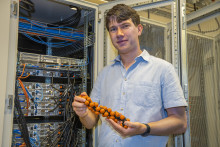Smell in mammals is an important sense that detects trace amounts of gases in the environment. It provides crucial information about the surroundings: the presence of food, a predator or prey, or toxic substances that should be avoided. Mammals can detect thousands of different odors, including complex scent mixtures in sometimes extremely low concentrations. These blends of scent molecules are captured by specialized receptor cells in the nose, which subsequently send a signal to the brain. Some receptors can bind a limited selection or even just one scent molecule only, while others are less specific and bind to almost any chemical. The combination of the different signals sent to the brain results in the detection of a specific smell.
Detection of disease
An artificial smelling device can have important advantages with many applications. For example, in the food industry, where it can be used to control product freshness or follow a fermentation process. In the chemical industry, an artificial nose could monitor the formation of chemical substances, including toxic gases. There are also numerous applications in medical diagnostics, for example for the detection of volatile disease biomarkers. However, to mimic mammalian smell in an artificial system is really challenging due to its efficiency and sensitivity. ‘Designing a sensitive artificial nose has quite some technological challenges,’ Smook says. ‘Such a device has to mimic the natural receptor, which is capable of binding many different chemicals at very low concentrations. This binding subsequently has to result in a signal and finally that signal needs to be interpreted.’
‘Designing a sensitive artificial nose has quite some technological challenges’
Molecular brush
As a start in dealing with these challenges, Smook focused his research on the first step of smell: the binding of a gaseous odor molecule to a receptor. As an artificial receptor, he designed a so-called polymer brush. This brush consisted of many polymer molecules, attached to a surface. Polymers are long-chained, flexible molecules that can be created in different shapes and sizes. Smook: ‘We can adapt their chemical and physical properties in such a way that they bind to odor molecules.’ To make the polymers work more effectively, Smook placed them really close together on a surface, so they were forced to stretch out forming some kind of brush hairs. Scent molecules could subsequently be captured by these polymer hairs.
Virtual space
Surprisingly, Smook’s research did not take place in a real laboratory, but instead, his computer functioned as his experimental set-up. In this simulated space, he designed virtual gas (odor) mixtures and virtual polymer brushes with different properties. Then, he modelled their interactions. Did the different (virtual) odor molecules repel or attract each other, and how did the polymer brush bind the different scent molecules present in the gas mixture? By subsequently varying the properties of the polymers and using different molecular odor mixtures, he gained more insight in the factors influencing the scent molecule-brush attachment.

‘Using the model, we could simulate how these gas molecules reacted to each other in terms of attraction or rejection and how this influenced their connection to the brush,’ Smook explains. ‘Where and how are these molecules attached to the brush and how do variations in the gas mixture as well as the brush hair density influence this process?’ His simulations showed similar behavior of scent molecules as in a human nose: when one particular gas had a strong attraction to the polymers, other gases could be pushed out. This means that multiple scents can influence each other, making it more difficult to interpret the signal from a single sensor. ‘To solve this problem, we need multiple sensors that are all coated with a different brush,’ Smook continues. ‘This way, each sensor looks at the scent from a slightly different perspective, and together they create something like a fingerprint through which it can be recognized.’
Higher sensitivity
After this first successful step, Smook further developed his artificial nose by trying to increase its sensitivity, so really low scent concentrations could be detected. Therefore, he aimed to increase the amount of scent molecules that are trapped inside the brush: more attached scent molecules would result in a potentially stronger signal. To achieve this, he used two different polymers in the brush: they repelled each other, but had similar affinity for the odor molecules present. By placing these different polymers in alternating rows, the repelling polymer rows bend slightly away from each other, creating more space. ‘Because of this space, the odor molecules could now attach to the top of the brush and also in between the polymer rows, so more odor particles are captured,’ Smook explains. ‘This theoretically results in a stronger signal, and thus a higher sensitivity.’ Especially at low scent molecule concentrations, this mixed brush was able to concentrate odor molecules efficiently, resulting in a ten times higher sensitivity, Smook found. This mixed polymer design is very promising for the first step in developing an artificial nose and even applications in separation technologies.

Solid guidance
After finishing his MSc, Smook will continue with a PhD at the same department within the framework of the NWO Program ‘Perspective’. There he will apply the principles and concepts of the polymer brushes to this program, to meet the challenges of a more effective waste separation and recycling of waste. ‘I am really happy to continue my research with the same supervisor, Sissi de Beer,’ Smook says. ‘Thanks to her enthusiasm and solid guidance, I managed to publish three papers during my MSc.’







